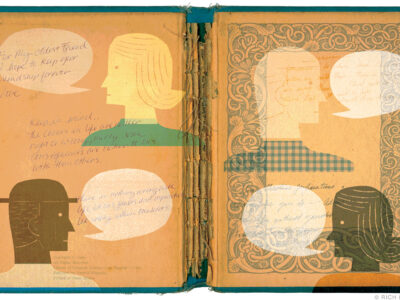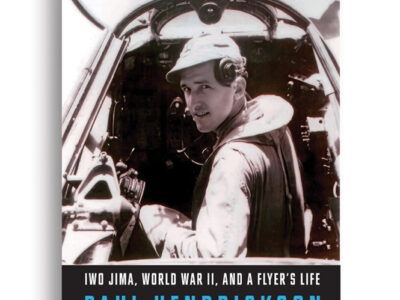Recreating the journey of a World War II airman in France.
By J. Robert Lennon

IN THE SHADOWS OF WAR: An American Pilot’s Odyssey Through Occupied France and the Camps of Nazi Germany
By Thomas Childers, Faculty
New York: Holt, 2003. $27.50.
In his 1995 book, Wings of Morning, Thomas Childers stumbled upon both an untold family story and a new way to tell it. Upon the death of his grandmother, he discovered, among her papers, letters from an uncle who had been killed when his B-24 bomber was shot down during the Second World War. Childers, the Sheldon and Lucy Hackney Professor of History and the author of three previous books on Nazi Germany, would discover that his uncle’s bomber was in fact the last to be shot down over Germany, and that the circumstances of his death were different from what his family had been told. The book, a riveting account both of his uncle’s experiences and of Childers’ own discovery of them, brought the author a mainstream audience, and a new writing technique: a third-person narrative style more commonly associated with fiction than history.
Wings of Morning, absorbing as it was, was also flawed: Childers’ command of dramatic narrative was weak, and because almost the entire bomber crew died in the crash, there were few firsthand recollections to draw from. At times, the book resorted to entire pages of invented dialogue to keep things going. There was nothing unethical about this—in an afterword, Childers was up-front about his intentions—but it did reveal the limitations of his method. Good dialogue should record the strange particularity of speech; Childers was forced to rely on plausibility instead. The result was stiff at best, sentimental at worst. Overall, however, the book was redeemed by its strongest parts; these included a surplus of well-researched detail and a present-day frame, in the author’s own voice, describing his search for the truth.
When I discovered that Childers’ new book lacked any such frame, however —that it was written entirely in the third-person limited point of view, through the eyes of the “characters”—I was worried. Could the historian write convincingly in the guise of a novelist? As it turns out, the new book is indeed problematic. But it is also ambitious, thrilling, and researched with extraordinary meticulousness, and should solidify Childers’ reputation as a popular historian of considerable skill.
The book traces the lives of three figures, as they intersect in Occupied France in 1944. Roy Allen, an American bomber pilot, is leading what ought to be an easy mission—a “milk run”—when his B-17 is strafed by German fighters and shredded by flak. The crew bails out, and the plane goes down. Reconstructed from Allen’s own recollections and those of his crew, the scenes describing the crash are taut and dramatic, displaying a confidence and literary proficiency that Childers’ previous book lacked.
We are then introduced to Colette Florin and Pierre Muslant, members of the French Resistance. Florin, a schoolteacher, shelters the downed pilot in her apartment and nurses his injuries, while Muslant tries to arrange his escape from France. The section describing the operations of the resistance and its efforts to evade Nazi detection are fascinating, informed by Childers’ encyclopedic knowledge of the time and place.
Getting Allen out of German-occupied territory, however, proves difficult, and the American, fed up with waiting, decides to undertake a risky escape, assisted by a cast of brave Resistance figures. But some of his handlers are working for the Germans, and he is betrayed. The second half of the book focuses on Allen, documenting his horrifying experiences in the hands of the Nazis, including a near-fatal incarceration at Buchenwald, a sojourn at a POW stalag, and several forced marches through the frozen countryside in the last days of the war. His tale is indeed extraordinary, and Childers’ research equally so: despite never having interviewed Roy Allen himself (Allen survived the war but died in 1991), the author has managed to reconstruct almost every waking moment of the airman’s life, and in so doing has created a document uniquely exhaustive in its descriptions.
Ironically, however, it is after Allen’s capture that the book begins to bog down. The reason for this is supplied, in an author’s note, by Childers himself. He writes, “I have tried to re-create the interrelated experiences of Roy, Colette, and Pierre, as they understood them at the time … without the intrusive—and distancing—presence of an omniscient narrator.” But such a narrator is exactly what is needed here. Third-person narrative is ideal for fiction, because it allows an author to document a character’s particular consciousness—his processes of thought, his interpretations of events. But unless he is writing a memoir, the historian has no such option. The distance Childers refers to is inherent and unavoidable: the historian must use his mind to bridge it. Without a guiding consciousness, then, this book’s concentration-camp scenes devolve into unrelieved lists of atrocities, and grow dull with repetition. We’ve heard these things before. It takes a guiding consciousness—such as Primo Levy’s in Survival at Auschwitz—to interpret them, to cast a human shadow upon them, to transform them into literary art. Childers, however, has written himself out of this book, leaving behind a marvelously detailed but ultimately soulless account. I would have preferred his direct interpretation, his own personality imposed upon the material—a technique employed by classics of the genre, such as Evan S. Connell’s witty Son of the Morning Star on George Armstrong Custer or John Hersey’s moving Hiroshima. It may be worth noting that Connell is better known as a novelist (Mrs. Bridge and other books), while Hersey’s oeuvre also includes many works of fiction as well as nonfiction.
Childers’ method also creates technical problems—foremost among them the difficulty of providing background material for historical context. As a result, we get much of our information through long paragraphs of expository dialogue, often in unconvincingly frenchified English. And we are sometimes left to wonder which impressions of the surroundings are truly Allen’s or his compatriots’, and which are simply plausible extrapolations based upon Childers’ knowledge of wartime Germany and France.
But the book’s limitations as a work of literary art in no way detract from its achievements as a work of history. Ten years in the making, In the Shadows of War really is astonishing, as if Childers himself had traveled, and suffered, with Allen, writing down everything he saw. The book’s endnotes are a testament to his labor, documenting the origin of every scene; it is easy to imagine him doggedly ferreting out every verifiable fact for the sake of verisimilitude. The result, even at its weakest moments, is completely gripping—I finished reading it at three in the morning and, lying in the dark afterward, wished there were more.
J. Robert Lennon C’92 is the author of four novels, the most recent of which is Mailman. His stories have appeared in Harper’s, McSweeney’s, and The New Yorker.




